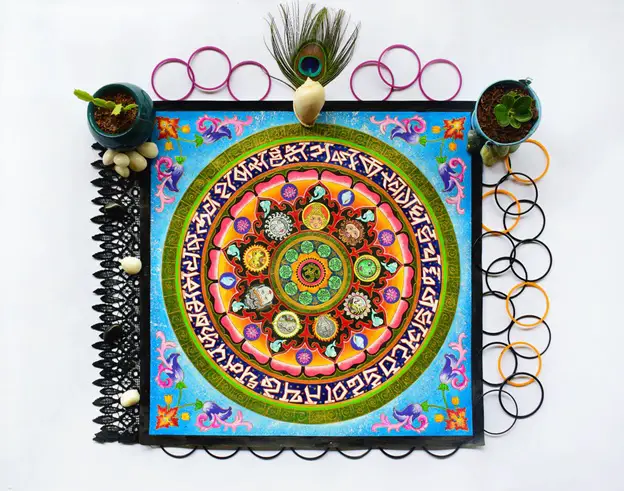Meanings
The founder of Buddhism, Prince Siddhartha Gautama, or Shakyamuni Buddha, lived in the 6th century BCE. However, the Buddhist symbols appeared later on over the years. The features of Budhha in statues include hand gestures, feet position, headwear, and a calm facial expression.
Symbols are an essential part of this religion since they convey its core principles. These symbols were used by various Buddhist traditions to spread their teachings to other parts of the world. Thus, they have played a key role in making Buddhism survive over the years. Moreover, each of these unique and inspiring symbols represents a different meaning and they are commonly found on carpets, ceramics, or furniture.
Here’s what some of the most interesting Buddhism symbols signify:

Om
Om, or Aum, is a three-part syllable that was originally the foundation of Hinduism but is now tied to Buddhism, Jainism, and other religions. The letter A represents creation, U represents manifestation, while M is for destruction, thus, it is used to symbolize the three stages of existence: birth, life, and finally, death. That is why most people think that it brings those three parts together. Moreover, in Buddhism, Om is used in the six-syllable mantra, “Om Mani Padme Hum,” which is chanted to instill the qualities of Guan Yin, the Bodhisattva of Great Compassion.
Bumpa
This treasure vase has different interpretations but is basically a symbol of wealth, deities, and prosperity. However, its spiritual meaning is connected to Budha’s teachings about the liberation of the mind. Thus, making it somewhat of an ironic symbol since the symbolism contradicts Buddhist principles. In short, it connects liberation with spirituality.
Enso
Enso, also known as the Zen circle or Circle of Enlightenment, is a popular symbol in Buddhism. This unclosed circle is mostly created with a single brushstroke, although some artists draw a complete circle. This sacred symbol is a visual expression for a circle containing everything or excluding everything by the closed boundaries, and was initially depicted as a roughly drawn, out-of-shape circle. However, it is used to indicate satisfaction because of both its emptiness and fullness. Thus, Enso expresses the complex idea of letting the body create whatever it wants while the mind is free. Basically, it symbolizes the beauty that exists within imperfections, teaching us to accept our inner self and finding a balance between all things in life.
Unalome
This is another powerful symbol of Buddhism that can be found in scriptures as well as the artwork. The Buddhist teachings explain that a person grows to be mature and wise by going through struggles and sufferings. By familiarizing yourself with the Buddhist belief of reaching nirvana, you can understand the unalome meaning and how it depicts the connection of a person’s life path with achieving clarity and enlightenment. Thus, according to the Buddhist tradition, this symbol is a representation of an individual’s path. Additionally, it embodies the existence of human beings and the role they play in this life.
Chatra
The parasol or umbrella is originally rooted in Indian tradition and symbolizes both protection and royalty. According to their tradition, this acted as a status symbol since the number of parasols an individual owned determined his position in the social hierarchy. However, this symbol was used to represent sovereignty, honor, and respect in the adaptation of Buddhism.
Gaurmatsya
The pair of golden fish are interpreted in different ways by different cultures. Initially, they represented the two sacred rivers in India, the Yamuna, and the Ganges. However, in Buddhism, this golden fish symbol is used to represent auspiciousness associated with freedom. This freedom is connected to the liberation that rebirth brings.
Mani
The “wish-fulfilling pearl” is a symbol used to represent spiritual wealth according to the teachings of Buddhism. On a deeper level, this symbol embodies the desire for wisdom and compassion, which can be achieved through meditation. Moreover, this ball of pearl shows the qualities of the founder of Buddhism.
Padma
The lotus flower is commonly known for growing out of the mud and rising above murky waters. According to Buddhist beliefs, humans can rise above desire and attachment, similar to this flower’s quality of blooming and remaining pure despite filth. By developing the virtues of Buddha, a person can go through a spiritual journey towards the end of the path in stages like that of the lotus flower. Since a fully bloomed lotus signifies the end goal in Buddhism, i.e., reaching enlightenment, a person can achieve this goal through phases of purity.

The information provided here shows how Buddhism has survived over the years by retaining each symbol’s unique meaning. Thus, all of the symbols are connected to achieving the state of enlightenment through spiritual awakening.


